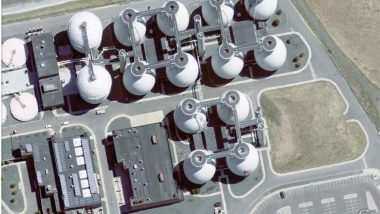“How Much Biogas is needed to make Electricity, or Drive a Car from organic waste?” That's a question often asked. We will provide an answer which has been achieved for one high-performance anaerobic digestion (AD) plant here, so READ ON!
What ferments longest, in the most optimised biogas plant makes the most biogas…
Watch our video below, which gives an example of how much it takes to make electricity or power a car, before returning to SCROLL DOWN and reading our full article, which places this video in context and provides the source of the data quoted in the video below:
<< Video Coming Soon >>
They say:
How Much Biogas is Produced from 1 Kg of Kitchen Waste?
One kilo of waste is sufficient to produce 0.07 cubic meters of methane.
How Much of this gas is Needed to Make A Useful Amount of Electricity?
One kilo of waste is sufficient to produce electricity that is powerful enough to light an energy-saving lamp for 50 hours.
How Much Biogas is Needed to Drive A Car a Distance?
One kilo of waste is sufficient to produce enough biogas to travel a kilometre or two kilometres by an eco-car.
Let us look at the example of one German biogas plant and the answer to the question of “how much biogas?” that they have provided in a press release (reproduced with a translation from the German original, and with edits, below):
Press Release Sueddeutsche Zeitung Magazin:
Biomass Fermentation Plant in Kirchstockach, 2011 to 2016 – Biogas Performance
It is remarkable that this anaerobic digester now generates five times as much electricity as it did over 20 years ago.
Furthermore, thanks to improved technology, it is produced by the plant without significantly increasing the feed input. The yield is so well optimised that the operators claim that it could only be increased further if citizens separated their garbage more cleanly.
Salad bowls, fruit bowls, coffee filters, kitchen paper, and plant remnants are all great ways to bring light into the dark. Organic waste contains a lot of energy.
This is what is achieved in Kirchstockach, Germany, where the County Council built a biowaste fermentation plant over 20 years ago. The biomass fermentation plant of the Landkreis in Kirchstockach is operated by Ganser Entsorgung. This is the bio-waste recycling plant of the district of Kirchstockach, Germany.
Since then, the annual electricity generation has been quintupled (raised fivefold).
After some initial difficulties and technical shortcomings in the first two years, the operating company Ganser recorded in 1999, after all, 1.12 million kilowatt-hours in 2016 for a recorded total of 5.1 million. 32 528 tonnes of biowaste were delivered last year, 30.5 of which was converted into 2.5 million cubic meters of biogas for the generation of electricity and heat in the combined heat and power plant. 35% of the biogas is converted into electricity, and 55% can be used as heat.
The digestate output can be used as fertilizer and as a peat substitute. [So, clearly, it should not just be a question of how much renewable gas an AD plant can produce, but also what other valuable products can it also provide.]
According to Landratsamt, last year, 4.1 million kilograms of carbon dioxide (CO2) emissions would have been avoided. The support of the citizens for this plant is still very good. The authority produces 26,000 tonnes of organic waste, which are produced each year in the county, which is 77 kilograms per inhabitant. The state capital of Munich also supplies another 6000 tons in Kirchstockach.

In recent years, there has been further investment in biogas plant technology. Originally, the plant had only been planned for a throughput of 20,000 tonnes of bio-waste. An expansion to 30,500 tonnes by the construction of a new large hydrolysis reactor in 2010, led to a shorter dwell time of the mass in the reactors. It also led to the increase in biogas production that is now achieved.
An additional factor was the renovation of the methane reactor so that the biogas yield in the past year compared to the year 2009 was improved. It rose by 34%, from 60 cubic meters to 81 cubic meters per tonne of organic waste.
Biogas production costs typically range between USD 0.22 and USD 0.39 per cubic metre of methane for manure-based biogas production and USD 0.11 to USD 0.50 per cubic metre of methane for industrial waste-based biogas generation, according to the International Biogas Association.
The organic fraction of Municipal Solid Waste is capable of generating of anything between 100–140 cu.m. of biogas per tonne.
CHP Use Improves the Carbon Emissions Savings Achieved
The Gymnasium Ottobrunn is also supplied with heat via a combined heat and power (CHP) heating scheme. Plus, hygienisation of the digestate (pasteurisation) is also carried out.
After all, the compost made from the digestate must be free of weed seeds and pathogens before it can be sold as a soil improver.
Sewage treatment and industrial facilities collect and use the biogas produced in anaerobic digesters to heat the digesters. However, in this facility, the demand for their own heat to be used in the plant to keep the digester warm has been reduced.
According to Managing Director Ulrich Niefnecker, this means that a higher amount of heat is available for transmission to third parties. Meanwhile, a contract on the supply of heat for the Gymnasium Ottobrunn has been concluded with the inclusion of heating for secondary schools in the southeast of the county. For four other schools, contracts were pending.
In order to be able to implement full thermal heat (CHP) utilization at the location, in the short term, 2014 saw the start of a new project. The time spent was not devoted to optimising how much biogas was produced, but using the heat for the best heating value.
A pilot experiment with the drying of wood chips and wood chips was undertaken successfully, and the project is now to be continued permanently.
“27 percent of waste heat is used for wood drying. The goal is one hundred percent,” says Niefnecker.
A practical solution has been developed for the wood industry:
“Dry wood burns better and you can store it without mould developing,” explained the managing director.
The operator of the plant is paid 75 euros per ten cubic meters of wood.
Future Work is Needed if Further Efficiency Gains are to be Achieved
According to Niefnecker, the improvements in the plant are currently largely exhausted. However, bio-waste recycling could still be further optimised if the municipalities could segregate the kitchen waste to an even better purity.
“Sand and glass splinters are always there.” said Niefnecker.
.
In the waste bins sent to the biogas plant, there is still land a lot of dirt and material, which does not belong there. The amount of sand that has to be extracted in the plant prior to the processing of the organic waste has increased. It has increased so that it reached a maximum of 2,300 tonnes, in 2016.
This means that 7.5% of the supplied so-called “organic waste” was sand.
Together with the branches, branches, plastics, stones and light metals which are also not desired, the amount of unfavourable substances is added to 6,192 Metric tons.
“Sand and glass splinter are always there, but we also often find potato peelers, cola cans or batteries,” the managing director said.
Thus, in order to improve the quality of the organic waste, it is necessary to achieve an even better separation of the substances before its introduction into the digester.
For example, green grass, flowers and foliage are the correct organic waste, while branches and logs are not.
Such material is used by the county, but only in other classifications of recycled material. Such unwanted material, should not be placed in garden waste and kitchen waste collections. This also applies to wood, earth, stones, general rubbish.
That's not all either, and it is a fact which many citizens do not know, probably because it is handled differently in Munich: for eggs and nutshells.
Compostable Plastic Bags for Organic Waste
The operators of the plant also strongly advise against the use of compostable plastic bags for organic waste.
“They are not distinguishable from other plastics and usually are not made from corn starch”, Niefnecker explained.
For that reason, the technique used by the biogas plant operators, is to pull out all the bags.
“We recommend paper bags,” Niefnecker explained.
Landratsamt now wants to publish a new, detailed bio-waste separation list for the municipalities. It also wants to improve the education of the public and promote a better separation.
via SuedDeutsche.de
— Press Release Ends —
What is Biogas?
Biogas is typically constituted of 60% methane and 40% carbon dioxide (CO2) by volume. It is analogous to natural gas, which is constituted entirely of methane (99%).

It can also be used to generate electricity. In the absence of pressure and temperature extremes, biogas is in the gaseous state, not the liquid state of LPG (propane).
Biogas can be burned directly as a fuel or treated to remove the carbon dioxide and other gases for use just like natural gas
Biogas that has been treated may be referred to as renewable natural gas or biomethane. There are many ways to turn biogas into biomethane, which is not only called renewable natural gas but also given the initials “RNG”. It can be used as a fuel for cars or injected into natural gas pipelines.
Where is biogas produced?
Biogas is produced in nature when organic waste breaks down in soil, marshes, the ocean, and other places.
Biogas is also made when organic food waste breaks down in anaerobic conditions in landfills.
Does biogas contribute to climate change?
While the combustion of biogas, like that of natural gas, produces carbon dioxide (CO2), a greenhouse gas, the carbon in biogas is derived from plant matter, which has fixed this carbon from atmospheric CO2. As a result, biogas production is carbon-neutral and when done correctly contributes nothing to greenhouse gas emissions. Furthermore, any consumption of fossil fuels that is replaced by biogas reduces CO2 emissions and can result in negative carbon emissions. In other words, can reverse the accumulation of CO2 in the atmosphere.
Other Benefits from Making as Much Biogas as Possible
In wastewater, biogas production can help to reduce the pollution potential by converting oxygen-demanding organic matter that could otherwise result in low oxygen levels in surface waters. It is possible to use biogas effluents to replace fertilisers in crop cultivation since nutrients such as nitrogen and phosphorus are saved in the waste.
Upgraded biogas is adaptable and may be used in the same applications as natural gas, including the powering of cars that run on the natural gas fuel supply line. Some countries have been aware of the possibilities of this technology for decades, and conventional cars that run on biogas are already on the road in some places.
Biogas as a car fuel is becoming increasingly popular on the roads, and Germany and Sweden were the two countries with the highest production of biogas as a vehicle fuel in 2016.
The Potential for Gains Toward Net Zero

Methane emissions would be reduced by an amount equal to the annual emissions of 800,000 to 11 million passenger automobiles in the United States if all of the potential biogas in the country were harnessed and used. Compressed natural gas created from biogas can lower greenhouse gas emissions by up to 91% when compared to petroleum fuel, according to a waste-to-wheels study.
Biogas is being used to generate electricity or steam at a lot of landfills, wastewater plants, and breweries, and it's increasingly coming from things like food waste. However, there are still many opportunities for biogas production that haven't been used yet. Until recently, the low cost of fossil fuels has made it difficult for biogas production to be used.
There are approximately 800 plants (2021) worldwide that produce biogas and convert it to natural gas, according to estimates. Their aggregate output is approximately 80 petajoule per year, which is the equal energy amount of approximately 1.8 billion gallons of diesel per year.
Worldwide consumption of liquid fossil fuels used annually reached more than 3,000 billion litres in 2014. Compared with that, 1.8 billion gallons is, of course, no more than a drop in the bucket. However, the global community has to get started somewhere, and the quantity of biogas produced to date is only a tiny proportion of the amount which could be created.
[Article originally posted in October 2017. Updated January 2022.]








How much did it cost to design and construction the plant used
We suggest that you read our articles on AD plant costs. To find our articles on the cost of anaerobic digestion plants search for “cost” using our search facility (top right), and read the articles which come up.
I often visit your website and have noticed that you always have good biogas information. But, here you say do not use biodegradable plastic bags. I disagree with you. The world must stop using plastic bags which are hurting more and more sea creatures. This is a crisis but you STILL say no to biodegradable plastic. You must change this if you have any care for animals.
Can you clarify your statements in the last couple of paragraphs? In one line you say “Their aggregate output is approximately 80 petajoule per year, which is the equal energy amount of approximately 1.8 billion gallons of diesel per year.” and in the next paragraph you say “Worldwide consumption of liquid fossil fuels used annually reached more than 3,000 billion litres in 2014. Compared with that, 1.8 billion litres ” so which is it? Gallons or litres, the units must all be the same to be a valid comparison.
Thanks for commenting on my error. The answer is that both should have been gallons. I have made the necessary change to gallons. Thanks for spotting the error. I must be more careful.